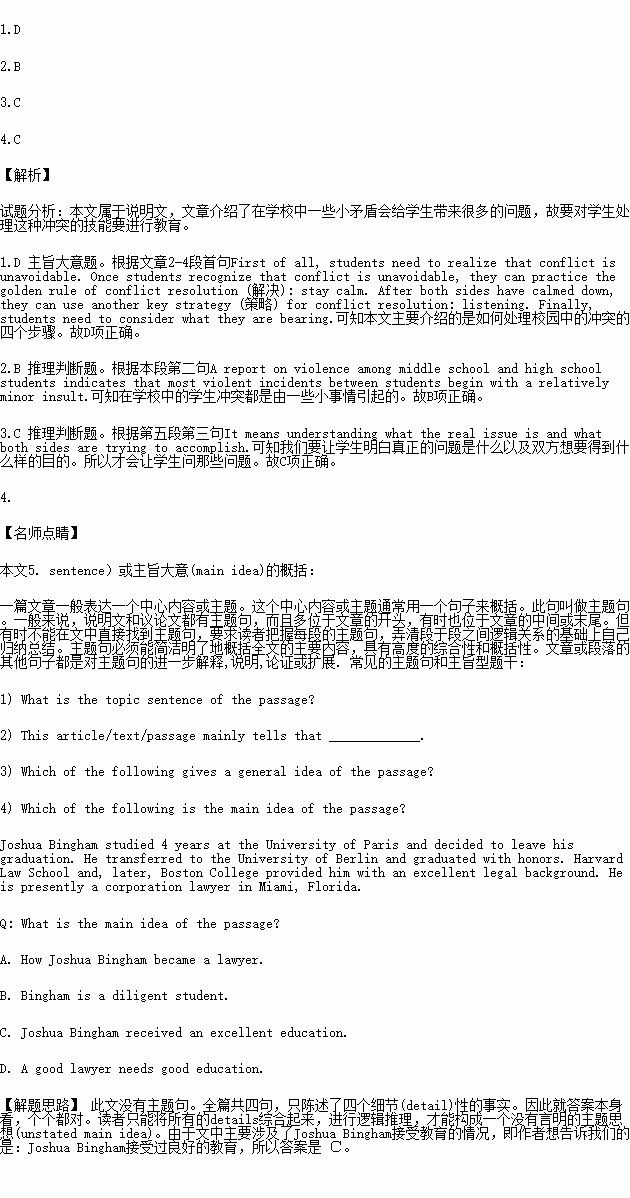题目内容
Two friends have an argument that breaks up their friendship forever, even though neither one can remember how the whole thing got started. Such sad events happen over and over in high schools across the country. In fact, according to an official report on youth violence, “In our country today, the greatest threat to the lives of children and adolescents is not disease or starvation or abandonment, but the terrible reality of violence”. Given that this is the case, why aren’t students taught to manage conflict the way they are taught to solve math problems, drive cars, or stay physically fit?
First of all, students need to realize that conflict is unavoidable. A report on violence among middle school and high school students indicates that most violent incidents between students begin with a relatively minor insult (侮辱). For example, a fight could start over the fact that one student eats a peanut butter sandwich each lunchtime. Laughter over the sandwich can lead to insults, which in turn can lead to violence. The problem isn't in the sandwich, but in the way students deal with the conflict.
Once students recognize that conflict is unavoidable, they can practice the golden rule of conflict resolution (解决): stay calm. Once the student feels calmer, he or she should choose words that will calm the other person down as well. Rude words, name? calling, and accusations only add fuel to the emotional fire. On the other hand, soft words spoken at a normal sound level can put out the fire before it explodes out of control.
After both sides have calmed down, they can use another key strategy (策略) for conflict resolution: listening. Listening allows the two sides to understand each other. One person should describe his or her side, and the other person should listen without interrupting. Afterward, the listener can ask non?threatening questions to clarify the speaker's position. Then the two people should change roles.
Finally, students need to consider what they are bearing. This doesn't mean trying to figure out what's wrong with the other person. It means understanding what the real issue is and what both sides are trying to accomplish. For example, a shouting match over a peanut butter sandwich might happen because one person thinks the other person is unwilling to try new things. Students need to ask themselves questions such as these:How did this start? What do I really want? What am I afraid of? As the issue becomes clearer, the conflict often simply becomes smaller. Even if it doesn't, careful thought helps both sides figure out a mutual(彼此共同的)solution.
There will always be conflict in schools, but that doesn't mean there needs to be violence. After students in Atlanta started a conflict resolution program, according to Educators for Social Responsibility, “64 percent of the teachers reported less physical violence in the classroom; 75 percent of the teachers reported an increase in student cooperation; and 92 percent of the students felt better about themselves”. Learning to resolve conflicts can help students deal with friends, teachers, parents, bosses, and coworkers. In that way, conflict resolution is a basic life skill that should be taught in schools across the country.
1.This article is mainly about ________.
A. the lives of school children
B. the cause of arguments in schools
C. how to analyze youth violence
D. how to deal with school conflicts
2.From Paragraph 2 we can learn that ________.
A. violence is more likely to occur at lunchtime
B. a small conflict can lead to violence
C. students tend to lose their temper easily
D. the eating habit of a student is often the cause of a fight
3.Why do students need to ask themselves the questions stated in Paragraph 5?
A. To find out who is to blame.
B. To get ready to try new things.
C. To make clear what the real issue is.
D. To figure out how to stop the shouting match.
4.The writer’s purpose for writing this article is to ________.
A. complain about problems in school education
B. teach students different strategies for school life
C. advocate teaching conflict management in schools
D. inform teachers of the latest studies on school violence

